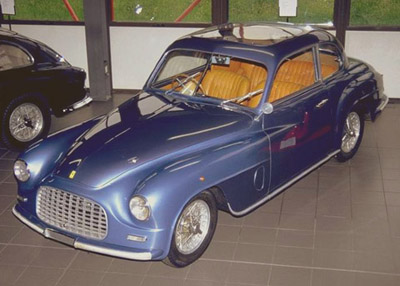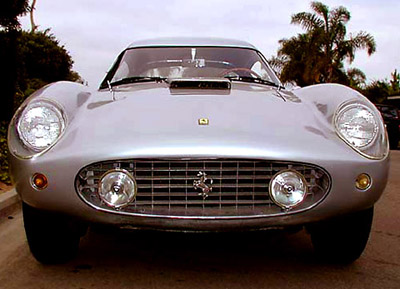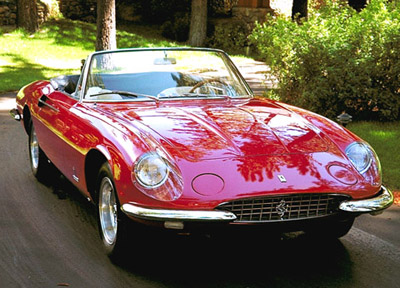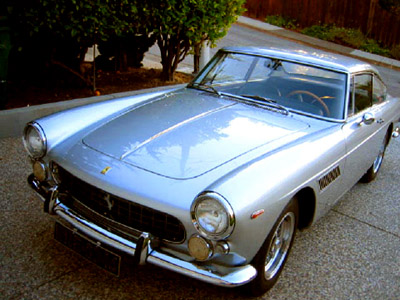Whenever someone who is
unfamiliar with old Ferraris attends a vintage concours event or
picks up a book on the subject for the first time, that person is
inevitably surprised to find that, for a small and specialized
manufacturer of nothing but two-door sporty cars, Ferrari offered
an impressive variety of road-going cars during its initial 25
years in the business. There were no four-door sedans,
wagons, trucks or vans, just an alarming number of grand touring
models that changed every couple of years or so and might appear
to present quite a bit of overlap.
By contrast, the post-war road
car offerings of manufacturer Aston Martin followed a simple
lineage, a single line of 2+2 grand touring coupes and
convertibles, for over fifty years. It has only been in
recent years that the folks at Aston Martin have expanded their
product line by offering three distinct models, each at a
different price point. Other manufacturers of sporty cars
supplemented their prime product by offering 2+2 or down-market
models, but none were as prolific as Ferrari.
While this array of early
road-going Ferraris may seem confusing at first, it's really quite
easy to grasp once one understands how each fits on the family
tree. Looking first at the V-12 cars, simply view them in
terms of four distinct lineages: the original grand touring
coupes, the more luxurious "America" line, the sportier "Berlinettas"
and the roomier 2+2s. In addition, there have been
convertible versions of each of these along the way (with the
exception of the 2+2s).
THE GRAND
TOURING COUPES
Pinning down exactly which
car constitutes the first Ferrari road car isn't exactly a cut and
dry matter, but the first model line to be specifically designated
as something other than its racing
cousins was the 166 Sport.
Labeled "Sport" in difference to the 166 "Corsa"
racing cars and receiving odd serial numbers (something that would
come to be strictly associated with the road cars), these early
Ferraris have managed to earn a place on my family tree of
street-going touring cars, even though both examples (s/ns 001S
and 003S) were raced with success (003S
was actually the 1948
Mille Miglia winner).
 The
next odd-numbered car, built on chassis number 005s, would be
quite a different story,
however. This car
first appeared at the Turin Motor Show in 1948 wearing tall and
arguably unsporting
coachwork by Touring. While a factory brochure produced that
same year used a
drawing of this car to illustrate the "166 Sport" and a drawing
and photo of s/n 003S to illustrate what was to be called the "166
Inter," it's obvious today that these were reversed, with "Inter"
being the new designation of Ferrari's first line of production
road cars. Even so, a small number of Inters would be driven
in competition, a fact that would also be true of the subsequent
195 and 212 Inter models. The
next odd-numbered car, built on chassis number 005s, would be
quite a different story,
however. This car
first appeared at the Turin Motor Show in 1948 wearing tall and
arguably unsporting
coachwork by Touring. While a factory brochure produced that
same year used a
drawing of this car to illustrate the "166 Sport" and a drawing
and photo of s/n 003S to illustrate what was to be called the "166
Inter," it's obvious today that these were reversed, with "Inter"
being the new designation of Ferrari's first line of production
road cars. Even so, a small number of Inters would be driven
in competition, a fact that would also be true of the subsequent
195 and 212 Inter models.
With the introduction of the
sportier Berlinetta line of cars in 1956, the grand touring coupes
would gradually become more elegant and further removed from their
competition cousins, culminating with the heavy yet comfortable 365 GTC/4 of
the early 1970s.
THE GRAND
TOURING BERLINETTAS
In 1955, the FIA (Federation
Internationale de l'Automobile) announced a new Gran Turismo
racing category to be comprised of production cars and divided
into separate classes by engine
displacement, one of these being
the 2.0 - 3.0 liter class. Ferrari was happy with the
reliability that the Gioachino Colombo-designed 3 liter "250"
motor had shown, both in racing (as used
 in the 250 Mille Miglia)
as well as in the 250 Europa GT road car, and so a new line
dual-purpose 250 GT "Berlinettas" cars was born. in the 250 Mille Miglia)
as well as in the 250 Europa GT road car, and so a new line
dual-purpose 250 GT "Berlinettas" cars was born.
The story of how the long
wheelbase cars would come to be dubbed "Tour de France" by the
public has been told too many times to be repeated here, as has
the tale of the homologation of the 250 GTO, of which no actual
road cars were ever produced. With the refusal of the FIA to
homologate the mid-engined 250 LM for the Grand Touring class,
however, the days of the true dual-purpose GT car were over, even
if the Berlinetta
line of road cars was not.
Much more of a street machine
than a racer, the 275 GTB's design was an evolution of the GTO
theme. While the factory did race a pair of special 275 GTBs
and also built and sold a number of other competition versions of
the car,
the ever-widening gap between what could be driven on the road and
what was capable of winning races, pushed the Berlinetta line
closer to that of the more civilized GT. In fact, many will
say that the 275 GTB was actually the successor to the 250 GT/L
but, while it might have been represented by the press (and
possibly even marketed) at the time as being such, the spiritual
replacement for the refined and elegant GT/L was, in my opinion,
the 330 GTC, that would appear two years after Lusso production
had ceased. For those that disagree, drop me a line and
speak your mind!
Another point open for
discussion is my feeling that the introduction of the 550/575
models marked a return to the grand touring line that ended with
the 365 GTC/4 and not, as claimed, an evolution of the Berlinetta
theme and a throwback to the front-engined 365 GTB/4 "Daytona."
While even the Daytona moved the line closer to the GT cars, it
was still a far cry from the luxury and comfort of the modern
front-engined two-seaters.
THE AMERICAS,
SUPERAMERICAS, SUPERFASTS AND A
 CALIFORNIA CALIFORNIA
While it's true that all 340 and 342 Americas
were constructed using even-numbered chassis, of the 22 or so 340
Americas built, more than a handful were strictly road cars, as
were the half dozen 342 Americas that followed. The
road-going 340s differed from their racing brethren not only in
appearance and appointments, but also in the use of a wet-sump
lubrication system.
With the introduction of the
375 America, this line of ultra-luxurious grand touring cars
became little more than larger displacement versions of the 250
Europa and were, therefore, built using the same sequence of
odd-numbered chassis.
The "America" name would
eventually be expanded to "Superamerica" with the 410 and 400
models, and then to "Superfast" for the 500, borrowing the new
moniker from a series of Pininfarina show cars. The last in
the line, though, was built in cabriolet form only and dubbed the
"365 California," a name reminiscent of the sportier spyders that
had gone out of production only a couple of years prior. Due
to the fact that this car was offered only as a drop-top and was
designated "California," many assume that it was a replacement for
the 250 GT California. Once one understands that the
legendary 250 GT California was a spyder version of the race-bred
Berlinettas, it becomes clear that this large, heavy and luxurious
cabriolet was not aimed at the same buyer.
THE
2+2s
This line of cars
needs the least amount of explanation. The unprecedented
success of the 250 GTE did not go unnoticed by Enzo Ferrari.
There was obviously a substantial market for a
 roomier
grand touring coupe. For this reason, the 2+2 line of cars
has been the most linear and consistent. roomier
grand touring coupe. For this reason, the 2+2 line of cars
has been the most linear and consistent.
The chart below is intended as
a guide to enable readers to better visualize where each of
these four lines, and the models that they comprise, fits into the
family tree. The production dates are not meant to be exact,
but only a guide, as many model changes were made in mid-year.
There were also cases of preproduction prototypes being
constructed and shown a year or more prior to actual production.
I've also given the drop-top versions of the GTs ("Cabriolets")
and Berlinettas ("Spyders") their own columns, even though each
belongs to the line of models in the column to their left. I
realize that some of my views might be controversial and, as
always, I welcome comments and criticism.
|
YEAR |
V-12 COUPES |
V-12 CABRIOLETS |
V-12 GT BERLINETTAS |
V-12 GT
SPYDERS |
LUXURIOUS "AMERICAS" |
V-12 2+2 |
|
1947 |
166
Sport |
|
|
|
|
|
|
1948 |
166
Inter |
166
Inter Cabriolet |
|
|
|
|
|
1949 |
|
|
|
|
|
|
|
1950 |
195
Inter |
|
|
|
|
|
|
1951 |
212
Inter |
212
Inter Cabriolet |
|
|
340
America |
|
|
1952 |
|
|
|
|
342
America |
|
|
1953 |
250
Europa |
250
Europa Cabriolet |
|
|
375
America |
|
|
1954 |
250
Europa GT |
|
|
|
|
|
|
1955 |
|
|
|
|
410
Superamerica (Series I, II & III) |
|
|
1956 |
250 GT
Boano |
250 GT
Boano Cabriolet |
250 GT
TdF (LWB) |
|
|
|
|
1957 |
250 GT
Ellena |
250 GT
PF Cabriolet |
|
|
|
|
|
1958 |
250 GT
PF Coupe |
|
|
250 GT
California (LWB) |
|
|
|
1959 |
|
250 GT
PF Cab (Series II) |
250 GT
Berlinetta (Interim) |
|
|
|
|
1960 |
|
|
250 GT
SWB |
250
GT California (SWB) |
400
Superamerica |
250
GTE 2+2 |
|
1961 |
|
|
|
|
|
|
|
1962 |
250
GT/L "Lusso" |
|
250
GTO |
|
|
|
|
1963 |
|
|
|
|
|
330
America |
|
1964 |
|
275
GTS |
275
GTB |
|
500
Superfast |
|
|
1965 |
|
|
|
|
|
330 GT
2+2 |
|
1966 |
330
GTC |
330
GTS |
275
GTB/4 |
|
365
California |
|
|
1967 |
|
|
|
275
GTB/4
NART Spyder |
|
|
|
1968 |
365
GTC |
|
365
GTB/4 |
|
|
365 GT
2+2 |
|
1969 |
|
365
GTS |
|
|
|
|
|
1970 |
|
|
|
|
|
|
|
1971 |
365
GTC/4 |
|
|
365
GTS/4 |
|
|
|
1972 |
|
|
|
|
|
365
GT4 2+2 |
|
1973 |
|
|
365
GT4 BB |
|
|
|
|
1974 |
|
|
|
|
|
|
|
1975 |
|
|
|
|
|
|
|
1976 |
|
|
512 BB |
|
|
400 GT |
|
1977 |
|
|
|
|
|
|
|
1978 |
|
|
|
|
|
|
|
1979 |
|
|
|
|
|
400i |
|
1980 |
|
|
|
|
|
|
|
1981 |
|
|
512
BBi |
|
|
|
|
1982 |
|
|
|
|
|
|
|
1983 |
|
|
|
|
|
|
|
1984 |
|
|
Testarossa |
|
|
|
|
1985 |
|
|
|
|
|
412 |
|
1986 |
|
|
|
|
|
|
|
1987 |
|
|
|
|
|
|
|
1988 |
|
|
|
|
|
|
|
1989 |
|
|
|
|
|
|
|
1990 |
|
|
|
|
|
|
|
1991 |
|
|
512 TR |
|
|
|
|
1992 |
|
|
|
|
|
456 GT |
|
1993 |
|
|
|
|
|
|
|
1994 |
|
|
F512M |
|
|
|
|
1995 |
|
|
|
|
|
|
|
1996 |
(550
Maranello) |
|
550
Maranello |
|
|
|
|
1997 |
|
|
|
|
|
|
|
1998 |
|
|
|
|
|
456 M
GT |
|
1999 |
|
|
|
|
|
|
|
2000 |
|
(550
Barchetta) |
|
550
Barchetta |
|
|
|
2001 |
|
|
|
|
|
|
|
2002 |
((575
M)
M) |
|
575 M |
|
|
|
|
2003 |
|
|
|
|
|
|
|
2004 |
|
(575 M
Superamerica) |
|
575 M
Superamerica |
|
612
Scaglietti |
|
2005 |
|
|
|
|
|
|
|